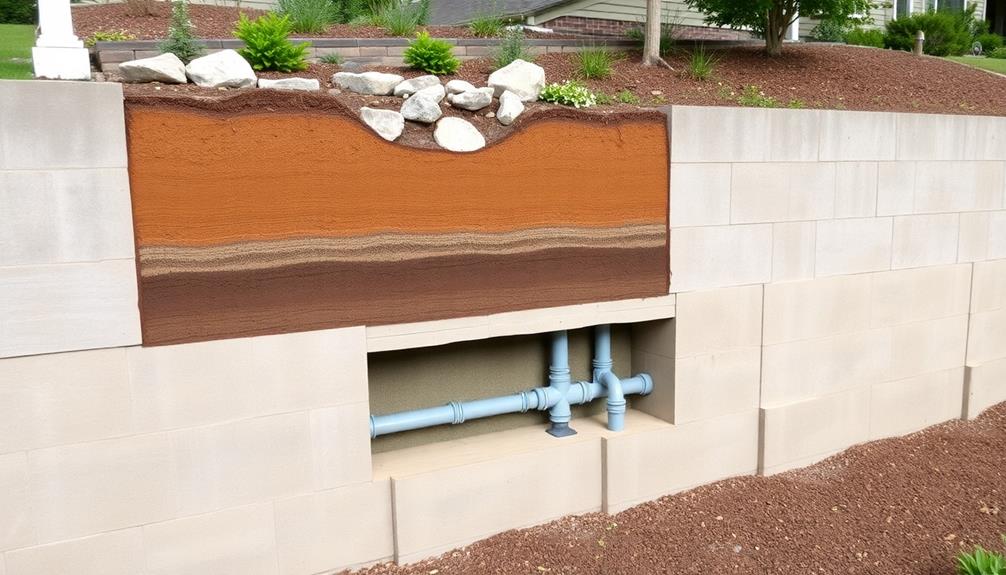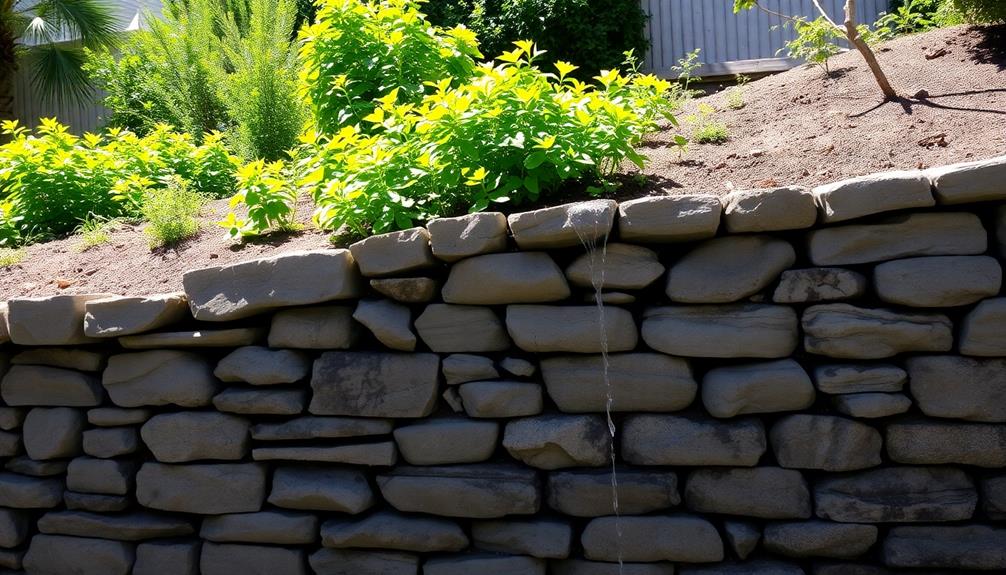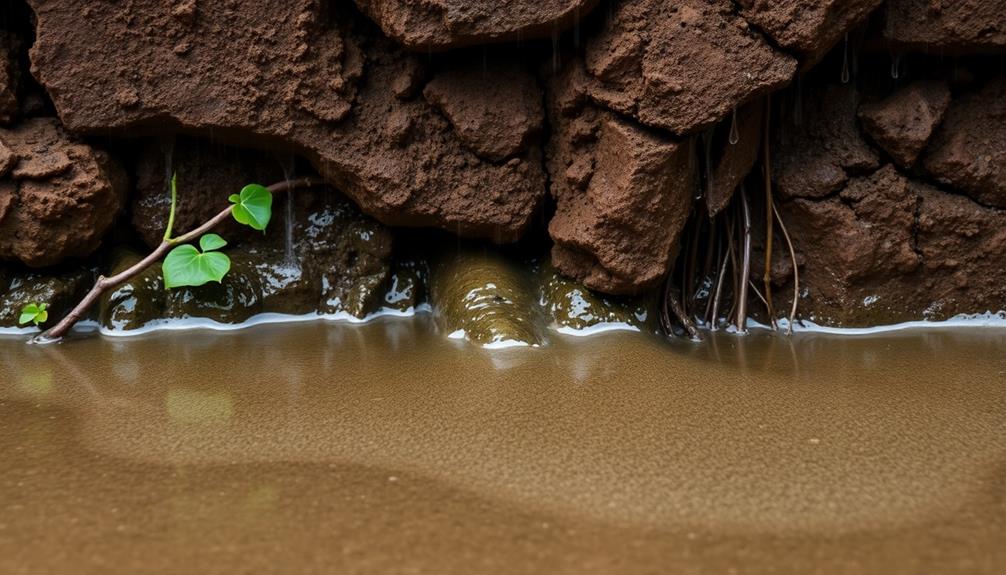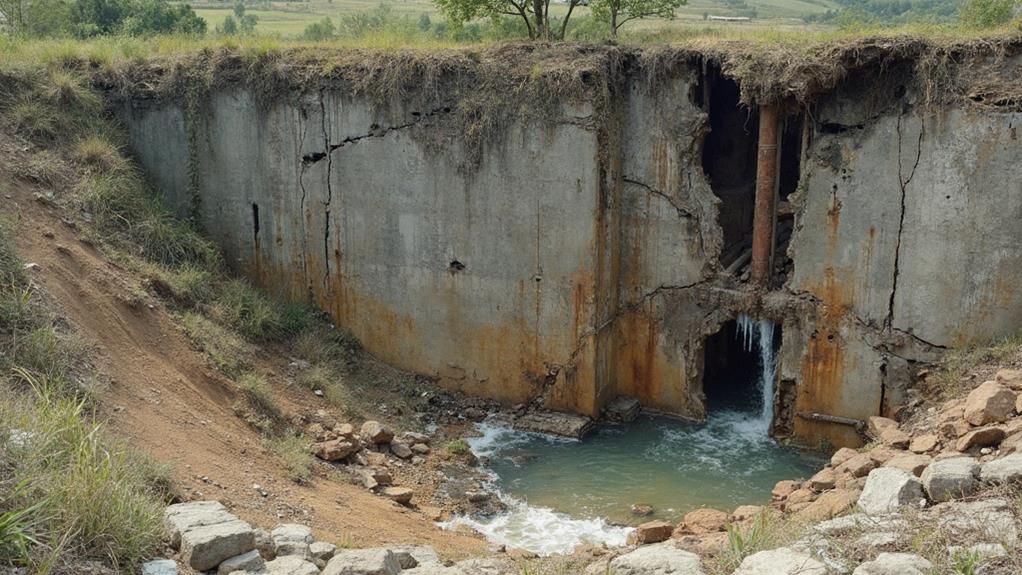Retaining walls, indispensable for landscape stabilization, face numerous challenges that can compromise their performance. Common issues include improper installation, structural integrity concerns, drainage problems, weathering and deterioration, and soil movement. Inadequate foundation preparation, insufficient drainage provisions, and improper backfill compaction often lead to wall failure. Structural problems may arise from inadequate wall thickness, reinforcement, or footing design. Drainage issues, such as clogged systems or hydrostatic pressure buildup, can cause significant damage. Weathering effects and soil movement further exacerbate these problems. Understanding these issues is pivotal for maintaining effective retaining walls and preventing costly failures. Exploring mitigation strategies can help guarantee long-term stability and functionality.
Table of Contents
ToggleWalls Contractor Highlights
- Improper drainage can lead to water buildup, causing structural damage and potential wall failure.
- Inadequate foundation preparation or insufficient footing depth can result in settling and instability.
- Poor backfill material selection and compaction may cause excessive pressure on the wall.
- Weathering and deterioration due to freeze-thaw cycles or corrosion can compromise wall integrity over time.
- Lack of proper engineering design may lead to walls unable to withstand lateral earth pressures.
Definition of a Retaining Wall

A retaining wall is a structural element designed to hold back soil or other materials, preventing erosion and maintaining different ground levels on either side. These walls can be constructed from various materials, including concrete, stone, brick, or timber, each offering distinct aesthetic and functional properties.
Companies like Boulder Walls offer specialized services such as building custom retaining walls and shoreline restoration to cater to the needs of Twin Cities homeowners. The key components of a retaining wall typically include the foundation, stem, drainage system, and backfill, working together to resist lateral earth pressures and guarantee long-term stability.
Purpose and Function
Stability forms the cornerstone of a retaining wall's purpose. These structures are designed to hold back soil, preventing erosion and maintaining the integrity of slopes or embankments. By resisting lateral earth pressures, retaining walls create level areas for construction, landscaping, or other uses in locations where natural topography would otherwise make such developments challenging or impossible.
The primary function of a retaining wall is to provide lateral support to soil masses, effectively creating two distinct ground levels. This capability is particularly valuable in urban environments, where space constraints often necessitate innovative land use solutions.
Retaining walls also play a vital role in managing water drainage, redirecting runoff to prevent soil saturation and potential structural damage. Additionally, these walls can enhance property aesthetics, creating visually appealing terraced landscapes and maximizing usable outdoor space.
In essence, retaining walls serve as important infrastructure elements, enabling the efficient utilization of land in both residential and commercial settings. Their multifaceted functionality encompasses not only structural support but also environmental management and aesthetic enhancement, making them indispensable components in modern construction and landscape design.
Types of Materials
Materials play an essential role in the construction and performance of retaining walls. The selection of appropriate materials is pivotal for ensuring the wall's stability, longevity, and aesthetic appeal. Common materials used in retaining wall construction include concrete blocks, poured concrete, natural stone, brick, and timber. Each material offers distinct advantages and challenges, catering to different soil conditions, environmental factors, and design preferences.
Concrete blocks and poured concrete are popular choices due to their durability and versatility. These materials provide excellent strength and can be engineered to withstand significant pressure from soil and water.
Natural stone and brick retaining walls offer a timeless aesthetic appeal, blending seamlessly with various landscaping styles. However, they require skilled craftsmanship for proper installation and may be more susceptible to water penetration.
Timber retaining walls, while cost-effective and easy to install, have a shorter lifespan compared to other materials and may require regular maintenance to prevent decay.
When selecting materials for a retaining wall, it is crucial to consider factors such as soil type, drainage requirements, climate conditions, and local building codes to guarantee optimal performance and longevity.
Structural Components Explained
Designed to hold back soil and prevent erosion, a retaining wall is a structural element that maintains two different ground levels on either side. These essential landscape features consist of several key components that work together to safeguard stability and longevity. Understanding these structural elements is indispensable for anyone considering installing or maintaining a retaining wall on their property.
The primary components of a retaining wall include:
- Foundation: The base that supports the entire structure
- Wall face: The visible portion that holds back the soil
- Drainage system: Allows water to escape, preventing pressure buildup
- Reinforcement: Internal supports that enhance wall strength
- Backfill: Material placed behind the wall for additional support
Each component plays a pivotal role in the wall's overall performance. The foundation must be properly excavated and compacted to provide a stable base. The wall face, typically constructed of concrete, stone, or timber, bears the brunt of the soil pressure.
A well-designed drainage system prevents water accumulation, which can lead to structural failure. Reinforcement, such as geogrid or steel bars, adds stability to taller walls. Finally, the backfill material contributes to the wall's load-bearing capacity and drainage properties.
Benefits

Retaining walls offer numerous advantages that extend beyond their primary structural function. These benefits include a potential increase in property value, effective erosion control, and enhanced landscape design possibilities.
For example, limestone walls can add an elegant, natural look while providing excellent support to prevent erosion. Meanwhile, shoreline restoration can transform waterfront areas, enhancing their aesthetic appeal. Moreover, they contribute to the creation of additional usable space on a property.
Increased Property Value
While many homeowners focus on the functional aspects of retaining walls, these structures can substantially increase property value when properly designed and installed. A well-constructed retaining wall not only enhances the aesthetic appeal of a property but also demonstrates a commitment to landscaping and structural integrity. This investment in outdoor infrastructure can additionally boost a home's market value, making it more attractive to potential buyers.
Retaining walls contribute to increased property value through:
- Creation of usable outdoor living spaces
- Enhancement of curb appeal and overall landscape design
- Prevention of soil erosion and property damage
- Improvement of drainage and water management
- Demonstration of property maintenance and care
The addition of a retaining wall can transform previously unusable sloped areas into functional spaces for gardens, patios, or recreational activities. This expansion of usable land effectively increases the property's square footage, a key factor in real estate valuation. Moreover, a professionally installed retaining wall signals to potential buyers that the property has been well-maintained and that significant investments have been made to preserve its long-term value and structural integrity.
Erosion Control
One of the primary benefits of retaining walls is their ability to effectively control erosion. These structures play an indispensable role in preserving the integrity of landscapes by mitigating soil displacement caused by wind, water, and gravity. By strategically redirecting water flow and stabilizing soil, retaining walls safeguard properties against the detrimental effects of erosion, which can lead to foundation damage, soil instability, and loss of valuable land.
Retaining walls utilize various mechanisms to combat erosion, including the implementation of proper drainage systems and the use of geotextile fabrics. These components work in tandem to manage water runoff, prevent soil saturation, and maintain the structural stability of the surrounding terrain. Additionally, the walls create a barrier that reduces the velocity of water flow, allowing for better absorption and distribution of moisture throughout the landscape.
For property owners seeking to protect their investments and maintain the aesthetic appeal of their outdoor spaces, retaining walls offer a thorough solution to erosion concerns. By incorporating these structures into landscape designs, individuals can guarantee long-term soil stability, preserve property boundaries, and enhance the overall resilience of their outdoor environments against the forces of nature.
Enhanced Landscape Design
Beyond their functional aspects, retaining walls frequently serve as striking design elements that enhance the overall aesthetics of a landscape. These structures can be seamlessly integrated into the surrounding environment, creating visually appealing terraces, gardens, and outdoor living spaces. By incorporating retaining walls into your landscape design, you can transform sloped or uneven terrain into usable areas while simultaneously elevating the visual appeal of your property.
When considering enhanced landscape design with retaining walls, several benefits emerge:
- Increased property value through improved curb appeal
- Creation of distinct outdoor rooms and entertainment areas
- Opportunity for incorporating water features or cascading gardens
- Flexibility in material selection to complement existing architecture
- Potential for integrating built-in seating or planters
The versatility of retaining walls allows for creative solutions to challenging topography while providing a canvas for personalized landscape expression. By carefully selecting materials, textures, and colors that harmonize with your home's exterior and surrounding vegetation, you can create a cohesive and visually striking outdoor space. This thoughtful integration of form and function not only solves practical issues but also contributes to a sense of belonging and pride in your property's unique character.
Additional Usable Space
A significant benefit of retaining walls is their ability to create additional usable space on a property. By strategically implementing these structures, homeowners can transform sloped or uneven terrain into functional areas, effectively expanding their outdoor living space. This expansion not only enhances the property's aesthetic appeal but also increases its overall value and utility.
Retaining walls can be employed to create level platforms for patios, gardens, or additional parking areas. In residential settings, they can be used to carve out space for outdoor kitchens, fire pits, or seating areas, providing homeowners with new opportunities for entertaining and relaxation.
For commercial properties, retaining walls can facilitate the construction of additional parking lots or create terraced landscapes for outdoor workspaces or recreational areas.
Moreover, retaining walls can be designed to incorporate built-in features such as planters, benches, or storage compartments, further maximizing the functionality of the newly created space. By reclaiming previously unusable land, property owners can optimize their real estate investments and create more versatile environments that cater to their specific needs and preferences.
Drainage Problems Behind Walls

Drainage problems behind retaining walls can lead to significant structural issues if left unaddressed. Inadequate water management systems, soil erosion, and hydrostatic pressure buildup are the primary culprits that compromise wall integrity over time. Understanding these factors is essential for maintaining the longevity and stability of retaining walls, as proper drainage solutions can mitigate potential damages and extend the wall's lifespan.
| Problem | Cause | Effect | Solution | Maintenance |
|---|---|---|---|---|
| Inadequate Water Management | Poor design or installation | Water accumulation | Install proper drainage systems | Regular inspection |
| Soil Erosion | Water flow behind wall | Loss of structural support | Use geotextile fabrics | Monitor soil levels |
| Hydrostatic Pressure | Water buildup | Wall displacement or failure | Incorporate weep holes | Clear drainage paths |
| Freeze-Thaw Cycles | Water trapped in soil | Expansion and contraction | Guarantee proper grading | Seasonal checks |
| Clogged Drains | Debris accumulation | Reduced drainage efficiency | Install filters | Clean regularly |
Inadequate Water Management Systems
The silent menace lurking behind many retaining wall failures is inadequate water management. When water accumulates behind a retaining wall, it exerts hydrostatic pressure, potentially leading to structural instability and eventual collapse. Effective water management systems are pivotal for mitigating these risks and ensuring the longevity of retaining walls.
Key components of an adequate water management system include:
- Properly installed drainage pipes
- Weep holes strategically placed along the wall's face
- Granular backfill material for improved water flow
- Geotextile fabric to prevent soil infiltration
- Graded landscape to direct water away from the wall
Implementing these elements helps prevent water buildup and reduces the likelihood of wall failure. However, many retaining walls suffer from inadequate or poorly maintained water management systems. This can result from improper initial design, cost-cutting measures during construction, or neglect over time. Regular inspection and maintenance of drainage systems are essential for identifying and addressing potential issues before they escalate. By prioritizing effective water management, property owners can remarkably extend the lifespan of their retaining walls and avoid costly repairs or replacements.
Soil Erosion Behind Walls
While proper water management systems are essential for retaining wall stability, soil erosion behind walls presents another important challenge. This issue often stems from inadequate drainage, improper backfill material selection, or compaction deficiencies during construction. As water accumulates behind the wall, it can gradually wash away soil particles, creating voids and weakening the wall's structural integrity.
Over time, this erosion process may lead to wall settlement, bulging, or even complete failure.
To mitigate soil erosion risks, homeowners and contractors should implement a thorough approach. This includes installing proper drainage systems with perforated pipes and gravel backfill to facilitate water movement away from the wall. Additionally, utilizing geotextile fabrics can help prevent fine soil particles from migrating through the drainage system while allowing water to pass through.
Proper grading of the area behind the wall is crucial to direct surface water away from the structure. Regular inspections and maintenance are indispensable to identify early signs of erosion, such as cracks, bulges, or settling, allowing for timely intervention. By addressing soil erosion proactively, property owners can considerably extend the lifespan and effectiveness of their retaining walls.
Hydrostatic Pressure Buildup
Retaining walls' biggest enemy often lurks unseen: hydrostatic pressure buildup. This phenomenon occurs when water accumulates behind the wall, exerting significant force that can compromise its structural integrity. Proper drainage is paramount to mitigate this risk, as it allows water to dissipate safely without causing damage. Homeowners and contractors alike must be vigilant in addressing this issue to guarantee the longevity and effectiveness of retaining walls.
To combat hydrostatic pressure buildup, consider implementing the following strategies:
- Install an extensive drainage system with perforated pipes
- Utilize gravel backfill to facilitate water movement
- Incorporate weep holes at regular intervals along the wall's base
- Apply waterproof sealants to the wall's rear surface
- Maintain proper grading to direct water away from the wall
Walls Contractor FAQ
How Long Does a Typical Retaining Wall Last?
The lifespan of a typical retaining wall varies depending on materials and maintenance. With proper care, a well-constructed wall can last 50-100 years. However, factors like soil pressure and drainage can impact longevity. Regular inspections are essential for optimal performance.
Can I Build a Retaining Wall Myself, or Should I Hire Professionals?
Building a retaining wall yourself is possible for small projects, but professionals are recommended for larger or complex walls. Consider your skill level, time, and the wall's importance to your property before deciding. Many homeowners find professional expertise invaluable.
What Materials Are Best for Constructing Retaining Walls in Different Climates?
When selecting materials for retaining walls, consider your climate. In colder regions, opt for frost-resistant options like concrete or stone. For warmer areas, wood or gabion walls work well. Always prioritize durability and local building codes for best results.
Are There Height Restrictions for Retaining Walls in Residential Areas?
Height restrictions for residential retaining walls often exist, varying by location. Typically, walls under 4 feet don't require permits, while taller structures may need professional design and approval. Always check local building codes for specific regulations in your area.
How Often Should Retaining Walls Be Inspected for Potential Issues?
Retaining walls should be inspected annually for ideal safety and longevity. However, more frequent inspections may be necessary in areas with extreme weather conditions or after significant events like earthquakes. Regular checks help identify and address potential issues early on.







